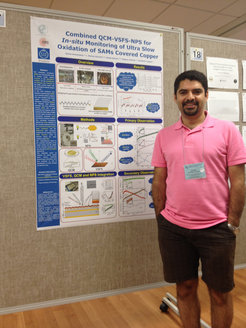In-Situ Monitoring of Ultra-Slow Oxidation of Copper in Atmospheric Pressure
Gordon Research Conference Poster Prize awarded to Saman Hosseinpour

Biddeford/Mainz. Saman Hosseinpour, a Postdoctoral researcher at the Max Planck Institute for Polymer Research (MPI-P), has been awarded a poster prize at the Gordon Research Conference (GRC) on Vibrational Spectroscopy 2014. The conference was held at the University of New England, ME, USA from August 3 to August 8.
The GRC, a non-profit organization, is committed to bringing young scientists together to discuss their current research and build informal networks with their peers. The Vibrational Spectroscopy conference brought together experimentalists and theoreticians working on modern vibrational spectroscopy.
Saman who was an invited speaker at the Gordon Research Seminar (GRS 2014) on Vibrational Spectroscopy, presented his work on in-situ monitoring of ultra-slow oxidation of copper in atmospheric pressure. Copper is one of the most common materials used in electrical contacts and heat exchangers but also in marine environments such as in desalination plants, ships and port constructions. Corrosion may lead to significant loss of functionality and consequently results in economic losses, environmental pollution and endangers human lives. Understanding the corrosion mechanisms at a molecular level would enable finding ways to slow down this degradation process. Therefore, Saman developed a new method to in-situ detect and quantify ultra-slow oxidation and corrosion of copper by integrating Vibrational Sum Frequency Spectroscopy, Quartz Crystal Microbalance, and Nanoplasmonic Sensing.
Saman obtained his PhD at the Royal Institute of Technology (KTH), a Swedish university, in 2013. His thesis focused on monitoring the oxidation of copper in a simulated indoor atmospheric corrosion condition. He is currently working in the Structure and Dynamics of Water at Interfaces group, an Independent Junior Research Group led by Ellen Backus. His research aims at unraveling at the molecular level the mechanism of water dissociation under the influence of light at the surface of a catalyst.












